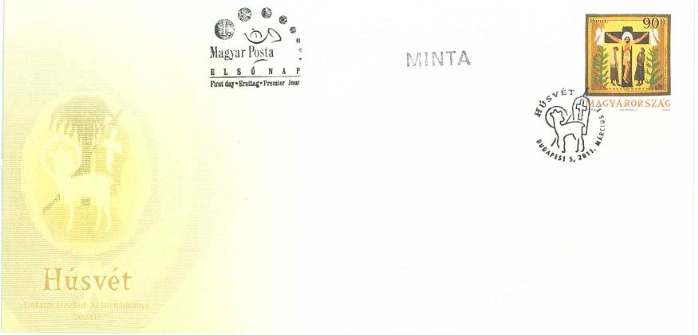Easter 2011
Date of issue: 1 March 2011
The stamp design uses a reproduction of a work by the textile
artist Erzsébet Szekeres entitled Hungarian Golgotha. The stamp’s first
day cover is adorned by a detail from another work by the same artist,
Lamb of God. The graphic design of the special postmark employs a
stylised version of the lamb on the cover.The word golgotha
is derived from the Hebrew gulgoleth, and the Aramaic transcription of
this (gulgalta) has been adopted and adapted in modern use. In Greek
this is kranion, while the Latin translation calvaria provides the
deriva-tion of our word calvary. The word means skull or place of
skulls. Originally, it was the name of a hill in a quarry north
north-west of Jerusalem, which was a place of execution in ancient
times. The name probably refers to the skulls remaining from the
executions. According to the Gospels this is the place where Jesus was
crucified and buried.
The precise spot is questionable but it is
probably at the right angle where the western and northern city walls
meet. The description given in St John’s gospel is also important as it
says that the place of execution was near the city as the sign fastened
to Jesus’ cross was read by many Jews (John 19, 19-20). It is possible
that it was next to the trade route connecting Jaffa and Ashkelon.

In AD 135 Hadrian built a temple dedicated to Jupiter over the site, and then in the 4th century St Helena, mother of the Emperor Constantine, constructed the present Church of the Holy Sepulchre there. Today it is surrounded by the Christian quarter of the Old City of Jerusalem. (Source: hu.wikipedia.org)
Order code: 2011021010031 (stamp) 2011021060032 (FDC)
Date of issue: 1 March 2011
Face value: HUF 90
Number of copies issued dependent on demand
Perforated size of stamp: 31.67 x 35 mm (50 stamps/sheet)
Printing method: 4 colour offset
Printed by Pénzjegynyomda P
hoto by Ildikó Neumann
Designed by Eszter Domé


